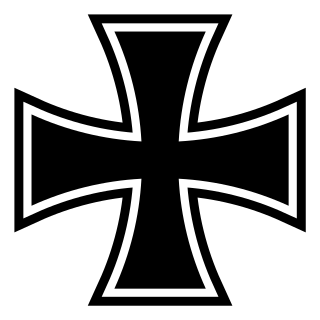
The Iron Cross was a military decoration in the Kingdom of Prussia, and later in the German Empire (1871–1918) and Nazi Germany (1933–1945). The design, a black cross pattée with a white or silver outline, was derived from the insignia of the medieval Teutonic Order and borne by its knights from the 13th century. As well as being a military medal, it has also been used as an emblem by the Prussian Army, the Imperial German Army, and the Reichswehr of the German Republic, while the Balkenkreuz variant was used by the Wehrmacht. The Iron Cross is now the emblem of the Bundeswehr, the modern German armed forces.
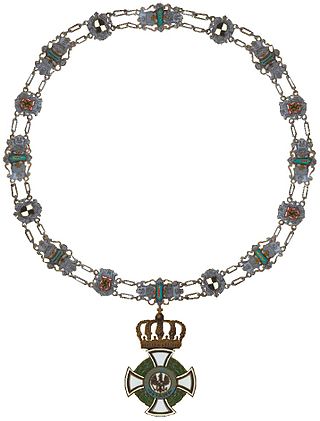
The House Order of Hohenzollern was a dynastic order of knighthood of the House of Hohenzollern awarded to military commissioned officers and civilians of comparable status. Associated with the various versions of the order were crosses and medals which could be awarded to lower-ranking soldiers and civilians.
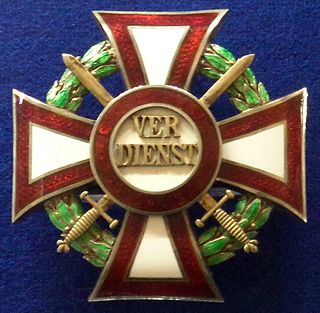
The Military Merit Cross was a decoration of the Empire of Austria and, after the establishment of the Dual Monarchy in 1867, the Empire of Austria-Hungary. It was first established on October 22, 1849 and underwent several revisions to its design and award criteria over the years of its existence. It became obsolete in 1918 with the dissolution of the Austro-Hungarian Empire.

The Military Merit Cross (Militärverdienstkreuz) was established by Friedrich Franz II, Grand Duke of Mecklenburg-Schwerin on August 5, 1848. Mecklenburg-Schwerin, a grand duchy located in northern Germany, was a member of the German Confederation and later the German Empire.

The Military Merit Medal was a military decoration of the Empire of Austria-Hungary. It was founded by Emperor Franz Joseph I on March 12, 1890. The Military Merit Medal is often referred to as the "Signum Laudis" after the inscription on the reverse of the medal.
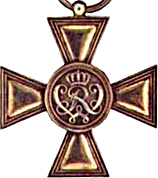
The Military Merit Cross was the highest bravery award of the Kingdom of Prussia for non-commissioned officers and enlisted soldiers. It was also known as the Golden Military Merit Cross to distinguish it from the Military Decoration 1st Class, a lesser Prussian enlisted bravery decoration which was an identical cross but in silver. The Military Merit Cross came to also be known as the "Pour le Mérite for non-commissioned officers and enlisted men", after the Pour le Mérite, Prussia's highest military decoration for officers.
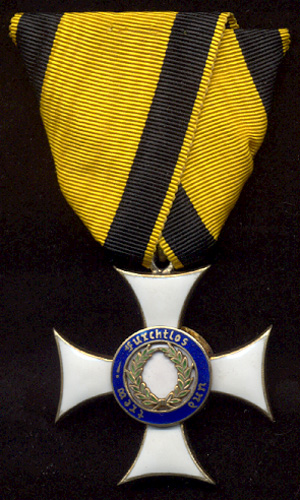
The Military Merit Order (Militärverdienstorden) was a military order of the Kingdom of Württemberg, which joined the German Empire in 1871. The order was one of the older military orders of the states of the German Empire. It was founded on 11 February 1759 by Karl Eugen, Duke of Württemberg as the Militär-Carls-Orden, and was renamed the Militärverdienstorden on 11 November 1806 by King Friedrich I. The order underwent several more revisions over the course of the 19th and early 20th centuries. It became obsolete with the fall of the Württemberg monarchy in the wake of Germany's defeat in World War I.

The Friedrich-August Cross was a German decoration of the First World War. It was set up on 24 September 1914 by Frederick Augustus II, Grand Duke of Oldenburg, with two classes, for "all persons of military or civilian status, who have shown outstanding service during the war itself".

The Medal for Services Rendered is a Belgian military service medal that was proposed to be created on 18 April 1988 by ministerial decree. It was intended to be awarded to members of the army, navy, air force and medical services of the Belgian Armed Forces for service rendered in particularly difficult circumstances over an extended time period. However, the creation of the medal was presented to the Council of State under the form of a ministerial decree and the Council ruled that the creation of such an award should be done by the King, thus via a Royal Decree. As a Royal Decree was never adopted, the medal was never officially created and has not or cannot be awarded.
The Military Medal For Gallantry (MMG) is a military decoration awarded by the Government of Ireland. It is the highest award of the military awards and decorations of Ireland.
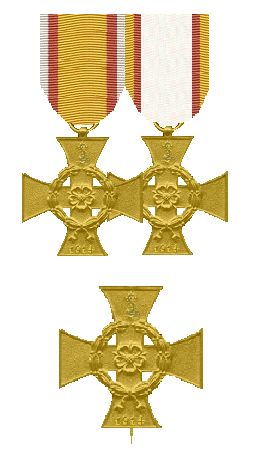
The War Merit Cross was a military decoration of the Principality of Lippe. Established on 8 December 1914, by Leopold IV, Prince of Lippe, it could be awarded to combatants and to non-combatants for significant contributions to the war effort. The cross was awarded approximately 18,000 times to combatants and 1,100 times to non-combatants.
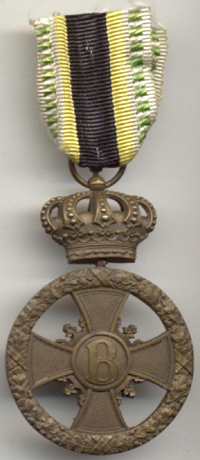
The Cross for Merit in War was a military decoration of the Duchy of Saxe-Meiningen established by Bernhard III, Duke of Saxe-Meiningen on 7 March 1915.

The Merit Cross was a meritorious service decoration of Prussia. Established 27 January 1912, by Wilhelm II in his capacity as King of Prussia, it recognized general merit to Prussia. The cross could be awarded to civilians as well as members of the military. The cross was awarded in two classes a gold cross and a silver cross.

The Merit Cross for War Aid was a war decoration of Prussia awarded during World War I. Instituted 5 December 1916, the cross was awarded for patriotic war aid service, without regard to status or rank.

The Military Honor Medal was a two-class military decoration awarded by the Kingdom of Prussia. The medal was awarded to military personnel from the rank of sergeant and below. Established in 1814, it replaced the Gold Military Merit Medal of 1806, with a medal in the shape of a cross silver cross for the 1st class while the Silver Military Medal of 1806 became the 2nd class with minor changes in design.

The Orient campaign medal was a French military medal bestowed for participation in the battles against the Central Powers by the Allied Eastern Army between 1915 and 1918.
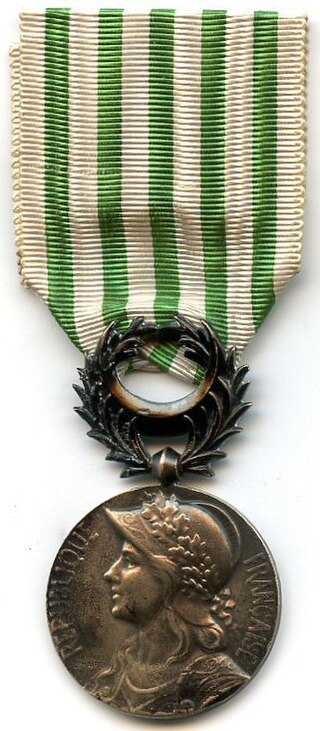
The Dardanelles campaign medal was a French military medal bestowed for participation in the Battle of the Dardanelles, also known as the Gallipoli campaign against the Central Powers by the Corps expéditionnaire d'Orient supported by the Royal Navy and French Navy between 25 April 1915 and 9 January 1916.

The Middle East operations commemorative medal was a French commemorative medal established on 22 May 1957 to recognize the participation of French nationals in the military operations conducted during the Suez Crisis of 1956.

The Düppel Storm Cross was a military medal of the Kingdom of Prussia. The cross was awarded to Prussian participants in the Battle of Dybbøl which took place on 18 April 1864, during the Second Schleswig War. Established by Wilhelm, King of Prussia on 18 October 1864, the cross was initially awarded to combatants and noncombatants who directly participated in the battle. The following year, versions were created for those troops held in reserve at the battle and members of the Johanniter Orden who participated in the battle.
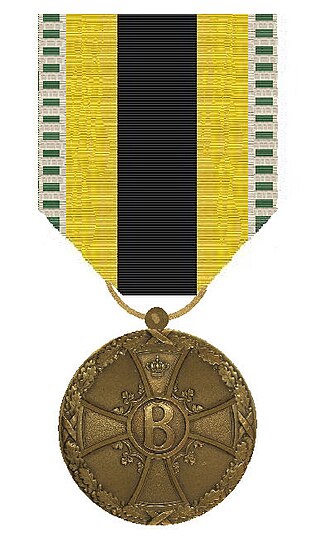
The Medal for Merit in War was a military decoration of the Duchy of Saxe-Meiningen, established during World War I on 7 March 1915 by Bernhard III, Duke of Saxe-Meiningen. For officers, there was the Cross for Merit in War, while the Medal was for enlisted personnel.




















